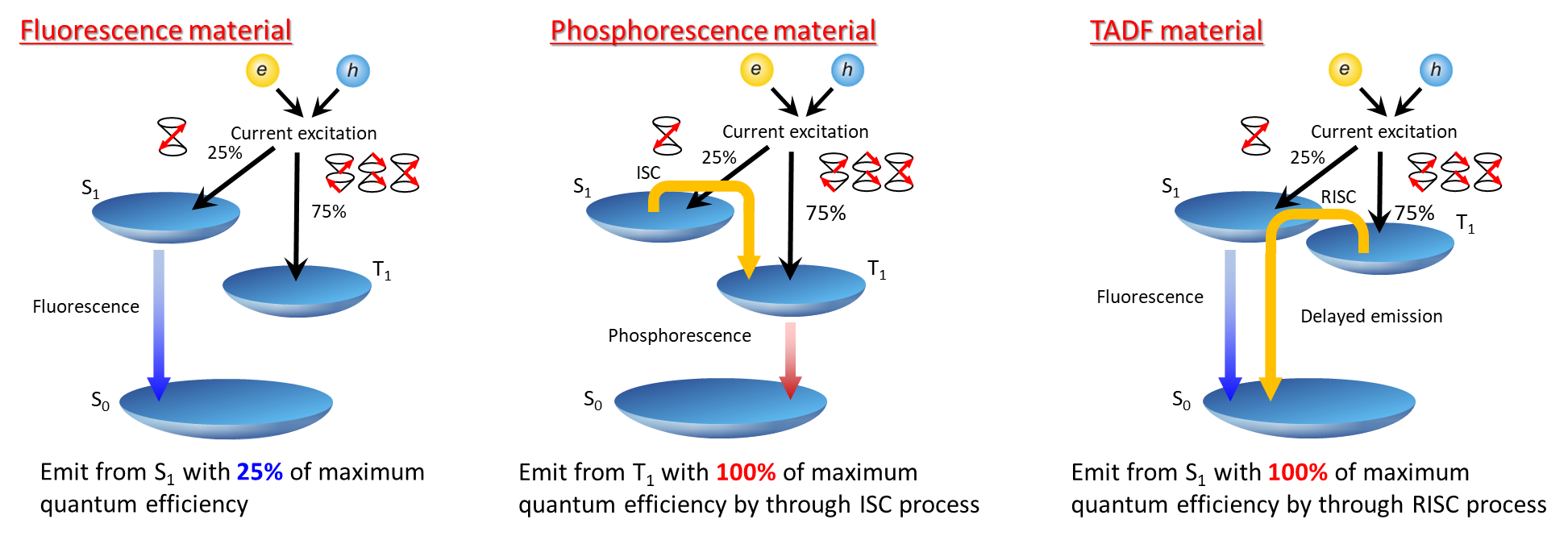An experimental method for clarifying excited-state energy alignments

TADF materials, the third generation OLED emitter
Ever since thermally activated delayed fluorescence (TADF) materials were first employed as emitters in organic light-emitting diodes (OLEDs) in 2009 (Adv. Matter. 2009, 21, 4802), our research group has focused on their potential. In 2012, we successfully developed highly efficient OLEDs that achieved theoretical maximum performance without relying on heavy metals (Nature 2012, 492, 234). Since then, TADF materials have attracted growing global research interest.
As illustrated in Fig. 1, electrical excitation generates excitons in a 1:3 ratio of singlet to triplet states. First-generation OLEDs, which utilize fluorescent emitters, can harvest only the singlet excitons, leaving triplets unused, an efficiency of 25%. A major breakthrough came with phosphorescent materials, which achieve nearly 100% internal quantum efficiency through the harvesting of triplets via intersystem crossing (ISC). TADF materials also reach 100% efficiency, but through reverse intersystem crossing (RISC), enabling triplet excitons to upconvert to the singlet state (S₁) and emit light. We believe TADF materials are transformative not only for OLED technology but for the broader field of photophysics.

How to know ΔEST of developed materials
In TADF material development, we have frequently encountered challenges in accurately determining the energy configuration of excitonic states. Minimizing the singlet–triplet energy gap (ΔEST) is key to achieving efficient TADF performance. However, we were surprised to discover a lack of reliable experimental methods to directly determine this gap. Typically, S₁ and T₁ energies are estimated from the onsets of fluorescence and phosphorescence spectra, respectively (Fig. 2). Yet, some materials exhibit phosphorescence at shorter wavelengths than fluorescence. Some researchers suggest using the shortest vibronic peak in the phosphorescence spectrum to estimate T₁, which can be effective in certain cases, but not universally. Others propose that the observed phosphorescence may arise from higher-lying triplet states (Tn). Despite extensive discussion, a consensus remains elusive. Moreover, a critical issue in ΔEST estimation from spectra is the underlying assumption that the ground-state energy (S0) remains constant across all conditions. Thus, our conclusion is that while spectral methods can yield reasonable transition energies for individual states, they are not reliable for determining ΔEST due to their inherent subjectivity.

Given this uncertainty, ΔEST is often estimated kinetically using the Arrhenius equation (Fig. 3). However, until recently, progress in understanding TADF kinetics based on experimental data had been limited. A universal kinetic model for the three-state system (S₁, T₁, S₀) was proposed in 2021 (J. Phys. Chem. A 2021, 125, 8074). Moreover, this approach relies on a critical assumption: that the activation energy is temperature-independent. This implies that S₁ and T₁ energy levels remain constant with temperature, contradicting the known temperature dependence of solvation effects, especially at low temperatures. While the kinetic method performs well when ΔEST is relatively large, it must be applied with caution when ΔEST approaches zero.

Beyond the general understanding
We then studied a TADF material, TMCz-BO. TADF is characterized by thermally activated delayed fluorescence—higher temperatures increase the proportion of delayed fluorescence and shorten its lifetime. TMCz-BO, reported by our group in 2020 (Nat. Commun. 2020, 11, 1765), exhibits a sub-microsecond delayed fluorescence lifetime. To explore its luminescence mechanism in more detail, we measured transient photoluminescence in toluene and observed an anomalous behavior: the proportion of delayed fluorescence increased, and the lifetime shortened at lower temperatures—the opposite of typical TADF behavior. Furthermore, conventional analysis yielded negative values for both the activation energy (Ea) of RISC process and ΔEST (Fig. 4).

These results were independently verified by two researchers, but we initially suspected experimental error. We rigorously tested various conditions—temperature sweeps (low to high and high to low), photoluminescence quantum yield (PLQY) before and after measurements, and other controls. All results were consistent. We also consulted a former group member who developed TMCz-BO and confirmed he had observed similar behavior in solution, though his 2020 study focused on the solid state. This reassured us that we were observing a genuine and novel phenomenon.
Around the same time, a ChemRxiv preprint (later published as Nature 2022, 609, 502) reported a TADF material apparently violating Hund’s rule, with T₁ lying above S₁. We were excited that our findings might align, but faced a major issue: the negative activation energy for RISC. Since activation energy represents an energy barrier, it should be positive. We sought a theoretical basis and found a compelling explanation in Physical Chemistry by Atkins. It describes that negative activation energy can arise when the reaction’s initial state is governed by an independent, temperature-dependent equilibrium. In such cases, a negative activation energy signals the use of an inappropriate analytical model.
Recent computational and experimental studies have shown that efficient S₁–T₁ conversion in TADF systems often involves higher-lying triplet states (Tn). Our group previously reported this in 2019 (Nat. Mater. 2019, 18, 1084). However, this concept had not yet been applied to the experimental kinetic estimation of ΔEST.
In this study, we present the first experimental elucidation of detailed exciton dynamics in a TADF material near the zero-gap regime (ΔEST ≈ 0). By interpreting “negative activation energy” as a diagnostic feature rather than an error, we have developed a novel photochemical analysis method and established a new framework for understanding excited-state energy configurations. This approach enables high-resolution investigation of temperature- and solvent-dependent excitonic dynamics in TADF systems with very small ΔEST values.
Follow the Topic
-
Nature Communications

An open access, multidisciplinary journal dedicated to publishing high-quality research in all areas of the biological, health, physical, chemical and Earth sciences.
Related Collections
With Collections, you can get published faster and increase your visibility.
Women's Health
Publishing Model: Hybrid
Deadline: Ongoing
Advances in neurodegenerative diseases
Publishing Model: Hybrid
Deadline: Dec 24, 2025





Please sign in or register for FREE
If you are a registered user on Research Communities by Springer Nature, please sign in